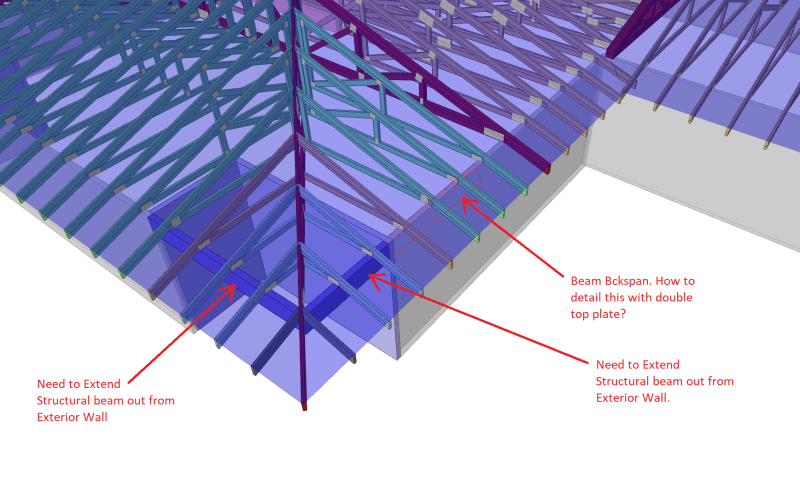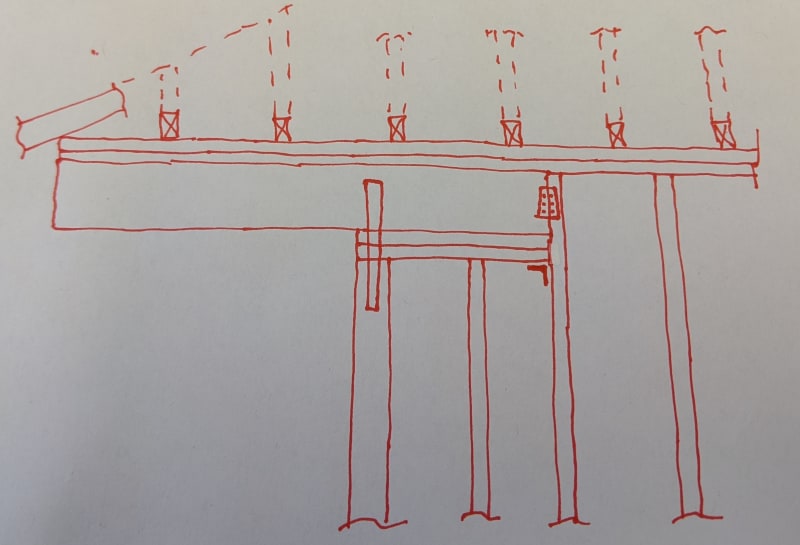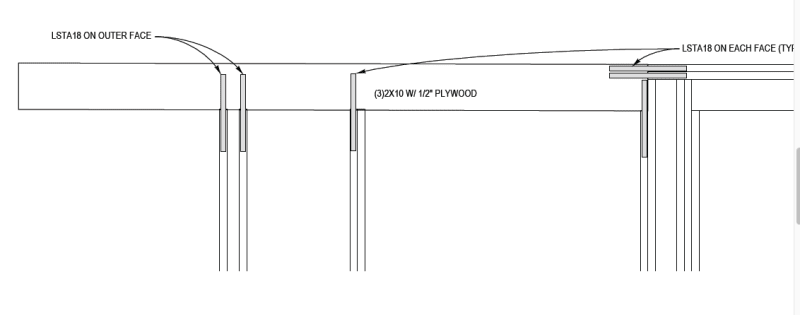I am always used to seeing the cripple studs installed above the header and below the double top plate. I think that for most scenarios this would be fine as the cripple studs can transfer the load from the top plate to header. However, what if you have a significant girder truss concentrated load coming down on top of your double top plate. Studs at 16" o.c. and trusses at 24" o.c. What if truss lands right between the studs? How do you address this? Would it be better to have the header beam installed directly below the top plate with cripples below?
Navigation
Install the app
How to install the app on iOS
Follow along with the video below to see how to install our site as a web app on your home screen.
Note: This feature may not be available in some browsers.
More options
Style variation
-
Congratulations TugboatEng on being selected by the Eng-Tips community for having the most helpful posts in the forums last week. Way to Go!
You are using an out of date browser. It may not display this or other websites correctly.
You should upgrade or use an alternative browser.
You should upgrade or use an alternative browser.
Cripple Studs above or below Beam Header 2
- Thread starter STrctPono
- Start date
- Status
- Not open for further replies.
- Thread starter
- #3
- Thread starter
- #4
It's standard practice here to add the extra cripples. Will you be doing inspections on this? If so, then you can make sure they get it. If not, then it's up to you. I've seen some people detail headers just below the top plate no matter what - some framers like it because they can get the walls up faster, and it gives some amount of flexibility if you want to use a taller window or make adjustments after the fact. It's the exception around here, though.
STrctPono:
Your structural logic is right on the money, but your carpenter logic is kinda bass-akwords. In most std. stick framing, you use the same size header materials, 2x8, 2x10, 2x12, whatever works most of the time for cutting standardization and material ordering. Then, all of the shoulder studs can be cut to the same length, by the hundreds. The same for cripples, hundreds of them, same length, and three or four of them make up the solid blocking under the large truss reaction. The kid distributing that mat’l. can see how many of each by looking at the layout on the t&b pls. Then, there will still be a few exceptions for crazy loads or wider or higher openings, etc. Also, with the header up under the top pls., you need special length shoulder studs and you still need a single 2x4 or 2x6 (stud size) to frame at the head of the window or door.
Your structural logic is right on the money, but your carpenter logic is kinda bass-akwords. In most std. stick framing, you use the same size header materials, 2x8, 2x10, 2x12, whatever works most of the time for cutting standardization and material ordering. Then, all of the shoulder studs can be cut to the same length, by the hundreds. The same for cripples, hundreds of them, same length, and three or four of them make up the solid blocking under the large truss reaction. The kid distributing that mat’l. can see how many of each by looking at the layout on the t&b pls. Then, there will still be a few exceptions for crazy loads or wider or higher openings, etc. Also, with the header up under the top pls., you need special length shoulder studs and you still need a single 2x4 or 2x6 (stud size) to frame at the head of the window or door.
- Thread starter
- #8
jayrod12 said:I always show posts below girders down to top of lintel. I even call it off as "provide xxx ply 2xwhatever post down to top of lintel"
This does sound like the best way to address it.
dhengr said:but your carpenter logic is kinda bass-akwords.
No arguing with you there. That's why I come to you guys to set me straight. Sadly, I have no other coworkers in my office that I can ask these questions.
This all makes much more sense. I do have another scenario though. I need to cantilever a 5.5 x 15 glulam out from the top of the exterior wall. I need a backspan on the beam but the level of the beam would be flush with the top plate. How would you detail this around the top plate seeing that it is at the same level. I feel as if I've seen this before with gable roof extensions but can't seem to find anything.

WeezerMike1
Structural
For that last picture, can you make the truss cantilever instead? That puts the complicated part onto the shoulders of the truss designer and your two beams could be simply supported instead of having one cantilever.
- Thread starter
- #10
-
1
- #11
-
1
- #12
WeezerMike1
Structural
Here's how I'd probably do it. I drew backspan is too short because I was lazy. =)
Running your double top plates out to the corner makes sure it's all tied back into your normal shear wall load path, but it adds depth to the overhang. You also could have top of beam equal top of double top plate if you stop the double plates at the start of the beam, and just strap the beam to the top plates.

Running your double top plates out to the corner makes sure it's all tied back into your normal shear wall load path, but it adds depth to the overhang. You also could have top of beam equal top of double top plate if you stop the double plates at the start of the beam, and just strap the beam to the top plates.

- Thread starter
- #13
- Status
- Not open for further replies.
Similar threads
- Question
- Replies
- 11
- Views
- 2K
- Locked
- Question
- Replies
- 16
- Views
- 3K
- Question
- Replies
- 19
- Views
- 21K
- Locked
- Question
- Replies
- 13
- Views
- 6K
- Locked
- Question
- Replies
- 4
- Views
- 2K

